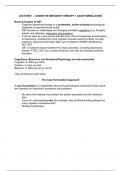LECTURE 1 – COGNITIVE BEHAVIOR THERAPY + CASE FORMULATION
Basic principles of CBT
- Cognitive behavioral therapy is a systematic, action-oriented psychological
treatment to improve mental health
- CBT focuses on challenging and changing unhelpful cognitions (e.g. thoughts,
beliefs, and attitudes), behaviors, and emotions
- It can be seen as a very broad umbrella term; that encompasses several types
of treatments, including the more cognitive focused variant by Beck, but also
exposure, behavioral activation (BA), and is related to EMDR, Mindfulness,
ACT, EFT
- CBT is evidence-based treatment for many disorders, including depression,
anxiety, PTSD, OCD, tics, substance abuse, and also for example psychotic
disorders
Cognitions, Behaviors and Emotions/Physiology are inter-connected
Cognition What you think
Emotion How you feel
Behavior What you do or not do
They all influence each other.
The Case Formulation Approach
A case formulation is a hypothesis about the psychological mechanisms that cause
and maintain an individual’s symptoms and problems.
- No direct link between the problem the patient presented and the treatment
plan
- Focus on understanding why (for example: why continue drinking despite the
many negative consequences?)
- Develop hypotheses
,An example of a case formulation for two separate clients:
Two people could have the same problem, but the analyses could direct to totally
different treatments.
- James reason is a coping mechanism against traumatic events, and Pete
drinks to socialize better
- In this case you see that James needs trauma therapy or EMDR, and Pete
would need social skills
Case Formulation Approach: Testing your hypotheses
- During treatment and the evaluation phase, you test your hypotheses
o Effective intervention? Reduction of symptoms?
- If the answer is no:
o Responsibility of therapist to go back to the individual
analyses/hypotheses: might they be incorrect?
o Also: should different therapeutical methods be used?
- Sum up: link the outcome of the evaluation with information gathering and
individual analyses
- With complex problems: individual analyses = better treatment effects
,Case Formulation Approach is more relevant for complex problems.
Different types of case formulations: in essence it’s all about analyzing your
patients
- Behavioral Case Formulation
- Cognitive Conceptualization Case Formulation
- Cognitive Behavior Case Formulation
THE CASE FORMULATION APPROACH – A SUMMARY
- Syntheses client experience, CBT theory and research
- It guides treatment
- Makes numerous, complex problems more manageable in the case of multiple
disorders
- Guides the selection, focus, and sequence of interventions
- Identifies client strengths and suggests ways to build client resilience
- Helps understand non-response in therapy and suggests alternative routes for
change
Example from the lecturer:
- Patiënt, newly mom. She was worried that she would strangle her baby or hurt
her baby otherwise. In her husbands family was an uncle with psychosis, so
she was worried about psychoses in her or her child.
- Lecturer created a case conceptualization. Started asking about:
o Whether she was in fights? Whether she was familiar with impulse
control problems? It seemed that she wasn’t likely to act out, but she
had a fear of acting out. So they decided to treat from the OCD
perspective.
o Psychosis was in her husbands family, so she wasn’t genetically prone
to developing psychoses. With psycho-education, client got some
reading on psychoses and the difference between OCD and psychoses.
FUNCTIONAL ANALYSIS
Individual Analyses and Conditioning Models
During the individual analyses you are doing a functional analysis to understand
the client better
Examples
- Why does a couple who have a too early born child in the hospital feel very
anxious when smelling sanitizers?
- Why is a woman always sitting on a chair at the end of the row in the
cinema, and not in the middle?
Conditioning models helps understanding behavior: both adaptive as well as
maladaptive behavior;
Operant conditioning and Classical conditioning models
, - Classical conditioning
o CS (bell) → US (steak) → UR (salvia) ; CS (bell) → CR (salvia)
- Operant conditioning Reinforcement increases behavior
o The Skinner Box: Skinner’s operant conditioning chamber (Skinner’s
box) was designed to teach rats how to push a lever. This behavior is
not natural to rats so operant conditioning with positive and negative
reinforcement were performed in order to teach the behavior:
Positive Reinforcement: Increase something positive [+S+]
Negative Reinforcement: Decrease something negative [-S-]
Reinforcement Increases behavior
Punishment Decreases the behavior
Positive = addition of stimulus
Negative = removal of stimulus
Why does a couple who have a too early born child in the hospital feel very
anxious when smelling sanitizers?
- Classical conditioning: [CS (Sanitizers) US (Early born child) UR/CR
(Anxiety)
Why is a woman always sitting on a chair at the end of the row in the cinema, and
now in the middle?
- Operant conditioning:
o Sitting at the end row will remove the feeling of anxiety because of
the easy exit [-S-] Negative reinforcement
o Sitting at the end row will increase her control [+S+] Positive
reinforcement
Individual Analyses: Functional Analyses
Functional Analyses – ABC
- Functional analyses: focus on the function of the problem/behavior
- Links to operant conditioning: a learning process through which the
strength of a behavior is modified by reinforcement or punishment (thus
the consequences)
- Focus on: when does it happen? Always? Or in certain situations? What
defines the context where the maladaptive behavior is present or absent?
Antecedents Activating event, also called Discriminating Stimulus (SD)
Can be external events (e.g. a comment from your boss) or internal events (e.g.
depressed feelings)
3 Elements of Functional Analyses: Activating Event – Behavior – Consequences
Antecedents/Activating event (Sd) Behavior (Response) Consequences
How to get input for a functional analysis?




